Three Colours White is the second film in Krzysztof Kieslowski’s The Three Colours Trilogy. The film is a black comedy which makes the title rather ironic.
The main character, Karol, is a Polish hairdresser who has met and married a beautiful French woman. Living in Paris, she decides to divorce him and leave him destitute. Karol manages to get back to Warsaw in a rather unconventional way and through various comical but shady deals, becomes wealthy. He fakes his own death and leaves his money to his ex-wife who comes to Warsaw to attend the funeral. After the funeral, Karol shows up at her hotel room and they spend the night together. When his wife wakes up, Karol has disappeared and the police arrive in her room accusing her of Karol’s murder. She realises that Karol has set her up, is arrested and ultimately ends up in jail. Karol visits the jail and stands in the courtyard looking up at her prison room where she stares out at him and indicates that she loves him. The movie ends with Karol in tears at this declaration.
The movie opens with a large suitcase moving on an airport conveyor belt whilst it is still in the underground part of the airport. At this stage the audience does not know why the suitcase is important and will only find out about 20 minutes further into the film. In some ways, seeing this suitcase, recognising that it must be important but not knowing at this stage why , creates a sense of anticipation in the storytelling. After the first shot of the suitcase, the scene cuts to Karol walking to the court for his divorce hearing. And again a cut to the suitcase on the conveyor belt.
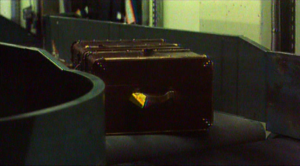
Kieslowski speaks of starting the movie this way for two reasons. The first so that all three films in this trilogy start in the same way; meaning that they show the scenes from underneath civilisation or technology. The first film begins underneath a car, this one under an airport and the third with a camera following some telephone wires. All of these things show how complicated simple things can be that we take for granted. The second reason for the suitcase shots was to juxtapose the suitcase moving with Karol moving toward his destiny at the courthouse.
The first indicator of the colour white is both comical and revealing of the one of the main themes. Karol arrives at the court house building and as he walks up the steps he disturbs some pigeons who fly up into the sky. He looks up and sees one of them flying overhead and then the audience sees pigeon dropping fall onto Karol’s shoulder. Kieslowski explained that with the pigeon marking Karol, he is also signifying to the audience that this person is important in this film. He saw this scene as summarising the entire movie; Karol scare the pigeons as he walks past, the pigeons fly off, Karol smiles at the pigeons, the pigeon messes on him, he feels humiliated by what has happened. Throughout the film Karol finds pleasure in things that end up causing him to be humiliated; most significantly his wife.
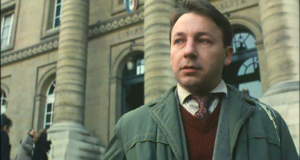
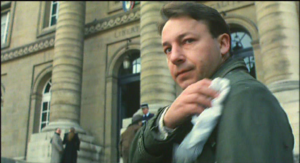
This scene is also a first indicator of the main theme of the film that not all are or want to be equal. At the start of the film, Karol isn’t equal to the others, he is clearly a misfit in his surroundings, he isn’t as educated or refined has his wife, the judge or anyone else in the courtroom.
Kieslowski spoke of how difficult it was to film the colour white, because it is not a colour and it is also difficult to make white appear dramatic.
It appears that when the scene is white, there is a relationship with the theme of equality and Karol is on an equal footing with the situation or the people. At one point during the court case, Karol has a flashback to his wedding day. The scene is over-exposed to accentuate the white and of course his wife is wearing white. At this point in their relationship he feels that they are equals.
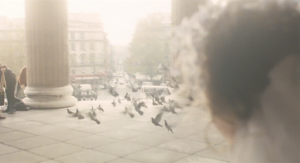
Later we see Karol with his hairdresser brother who is unsurprisingly wearing a white coat, indicating that Karol feels to be the same as his brother.
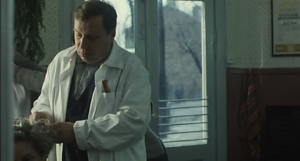
After Karol has ‘helped’ Mikolaj realise that he does not want to die – they go out and get drunk and then run across the frozen river. The scene is predominantly white. This is the first scene where Karol is now Mikolaj’s equal.
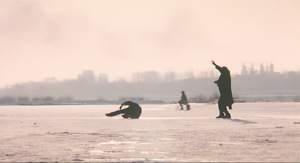
Interestingly, at the end of the movie when Karol and his ex-wife are in the hotel – the bed sheets are completely red giving a very strong signal to the audience that there is danger ahead and as it turns out, the danger is for the ex-wife. However, it may also be an indicator that Karol does not feel equal to his ex-wife but rather that he now has the upper hand and is feeling superior.
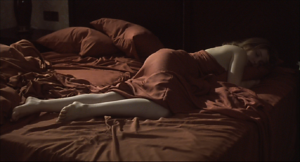
Overall, this seems to be the ‘lightest’ film of the trilogy with far less atmosphere and meaning coming from the colour and lighting than in Red and Blue.
Bibliography
Three Colours White [feature film, DVD] Dir. Krzysztof Kieslowski. MK2 Productions, France 3 Cinéma, CAB Productions, France, Poland, Switzerland. 1994. 91 min.
